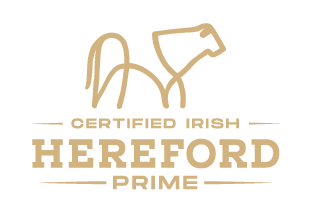Fertility, Frames and Fantastic Herefords
Animal health and soil fertility are the two pillars father and son duo, John and Sean Heffernan, base their Hereford calf to beef enterprise on.
Sean Heffernan is operating a Hereford calf to beef system in partnership with his father John in Co Galway. Having had a suckler herd many years, the pair decided to switch enterprises and became members of Irish Hereford Prime three years ago.
Calf Rearing
Sean and John rear 25 Hereford crossed calves every year. Sourcing animals primarily from Munster, the pair favour dealing with farmers directly. “We go to collect the calves from Clare, Limerick and Tipperary with our own trailer,” Sean says. “It might take a while, but it is a much better route. It reduces the stress on the animal and we are confident that the trailers are clean.” When the calves arrive on the farm, between three and four weeks old, their first feed is electrolytes. For their second feed, animals are weaned back onto their usual diet of milk replacer. “The calves are fed milk replacer for between 10 and 12 weeks,” Sean explains. “They will get 6 to 8 Litres as well as straw. Concentrates are also given immediately.” Before being weaned on the Heffernan farm, calves must be weighing between 90kg and 100kg and eating 1kg of concentrates for three consecutive days. Once weaned, the calves are put out to grass. “We fed 2kg of concentrates last year,” says Sean. “Everyone queries whether they needed that much – but they were performing well.”
Happy with Herefords
For the Heffernans, the toss-up was between Angus and Herefords. “We see a big difference between the male progeny of the Herefords compared to the Angus,” says Sean. “They are very easy cattle to rear and they are a very quiet breed – it has a lot to do with how you handle them as well.”
The Finish Line
Sean and John finished heifers for the first number of years and have since decided this year to move into bullocks. The pair finish animals in two to three batches and are hoping to get the first lot of animals away at the end of October at 21 to 22 months of age. “Some of the animals will finish off of grass and more of them will not. It really just depends on the weather around here,” Sean explains. “They have been brought in for the last number of years, but they would generally be indoors for four to five weeks.” Over the last four weeks, finishing animals have been on 4kg of high maize meal and as much grass as they can eat. They will remain on this diet for the next month. Concentrates will then increase to between 6kg and 8kg for another month before slaughter.
Heifers V Bullocks
Having experienced rearing both heifer and bullocks, the Heffernans find the bullocks the better option of the two. “We bought them for almost the same price (as the heifers), this year,” Sean remarks. “You get a bigger frame for almost the same price and they carry the same costs through the first winter.” However, Sean acknowledges that heifers take less meal to finish them and have the potential to finish off of grass.
Silage and Reseeds
Sean and John get a contractor in to make their silage bales. They find bales the easiest way to feed at a barrier and control the quality of the silage. Last year, two silage tests were done on the farm. The first test was 68 DMD and the other was 77 DMD, showing that recent reseeding work paid off. “We have done a good bit of reseeding in the last 2 years – around 25% of the farm,” Sean says. “Soil fertility was something that I totally neglected. I was going in with far too much nitrogen as opposed to compounds and lime.” Sean has since cracked the soil fertility code and is finding that the land is responding well to lime, Phosphorus and Potassium. However, he admits that he still likes his nitrogen.
Grass Measuring
Now that soil fertility is on track, utilising grass has been no issue for Sean and John through the use of grass measuring: “I thought myself how to do it using Pasture Base videos and figuring it out as I went along,” Sean laughs. “It is a phenomenal tool really, we were definitely grazing covers that were too high and not getting the utilisation out of it.” Not shy to spread the knowledge, Sean also grass measures for a number of local farmers.
Most Valuable
One of the most valuable resource made available to the Heffernans has been the faecal sampling service provided by Irish Hereford Prime. “It is a brilliant service,” Sean says. “You are shooting in the dark with your animal health otherwise. Before, I would have never thought we had an issue with fluke around here. With this, you have the knowledge of what you are going in to target.”
Moving Forward
Finishing animals are now between 550 and 560kg on the Heffernan farm. Sean hopes to push them on over the next 70 days to get them to between 620 and 650kg. Sean and John are also expecting results from their most recent faecal sampling. Moving into the autumn, the father and son duo hope to tackle any animal health issues before winter, while keeping a close eye on pneumonia. “If an animal catches pneumonia, even if you don’t lose them, any profit you have is going to be wiped out,” Sean says.
